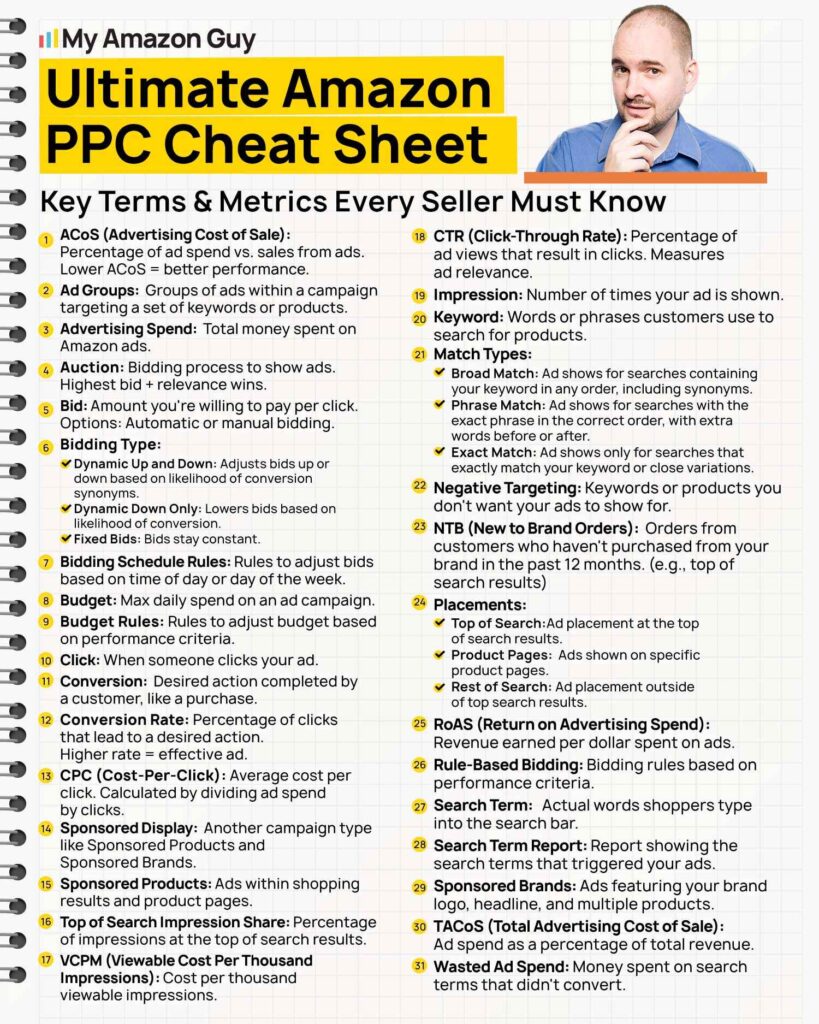When you check your Seller Central account, you’ll see various Amazon seller performance metrics like CR, LSR, and ODR. Each one has a number next to it, but what do these actually mean?
These metrics are not just random figures, they directly impact your ability to sell on Amazon. Poor performance can lead to lower search rankings, account restrictions, or even suspension.
Unfortunately, many sellers don’t realize how important these numbers are until it’s too late. By the time they take action, their account health may already be in danger.
That’s why our full-service Amazon agency created this guide to help you understand Amazon seller performance metrics. We’ll explain what they are, why they matter, and how you can monitor and improve them.
Table of Contents
Understanding Amazon Seller Performance Metrics
As an Amazon seller, there are many things to keep track of to ensure your business is running smoothly. From advertising performance to customer satisfaction, it can quickly become overwhelming.
Thankfully, Amazon provides performance metrics in Seller Central to help sellers monitor their account health and overall business performance. These metrics allow you to see what’s working, where you need improvement, and how Amazon views your seller account.
Amazon seller performance metrics cover various aspects of your business, including sales, advertising, inventory management, and customer satisfaction. By regularly tracking these metrics, sellers can make data-driven decisions to optimize their strategies and avoid potential penalties.
Why Monitoring Amazon Seller Performance Metrics Matters
Amazon provides seller metrics to give insight into account health, sales performance, and customer satisfaction. Here’s why monitoring these metrics is essential:
- Weak performance metrics may lead to penalties that affect your ability to sell on Amazon.
- Tracking conversion rates and sales data helps identify profitable products and optimize listings.
- Monitoring inventory levels ensures products remain in stock and prevents overstocking issues.
- Strong performance metrics improve Buy Box eligibility, leading to higher sales.
- Keeping customer satisfaction high reduces return rates and increases positive reviews.
Key Amazon Seller Performance Metrics
There are several key metrics that Amazon sellers must track to maintain account health, optimize sales, and stay compliant with Amazon’s policies. Monitoring these metrics helps sellers make informed decisions and avoid penalties that could impact their Amazon business.
1. Order Defect Rate (ODR)
The Amazon order defect rate measures how well a seller maintains customer satisfaction. Amazon requires sellers to keep this metric below 1%. A high ODR can lead to account suspension.
It consists of:
- Negative Feedback Rate: The percentage of orders that receive negative feedback.
- A-to-Z Guarantee Claim Rate: Claims made by customers when they experience delivery issues.
- Credit Card Chargeback Rate: Disputes raised by customers due to unauthorized transactions or billing issues.
2. Late Shipment Rate (LSR)
Late Shipment Rate tracks the percentage of orders that are shipped after their expected delivery date. A high LSR can negatively impact customer satisfaction and may result in account restrictions.
Timely shipping is crucial for maintaining strong performance metrics and meeting Amazon’s standards. Sellers should keep their LSR below 4% by optimizing fulfillment processes and using reliable shipping carriers.
3. Inventory Performance Index (IPI)
IPI measures how well sellers manage inventory. A high IPI score (above 400) ensures better storage limits and avoids excess storage fees.
It considers:
- Sell-through Rate: How quickly inventory sells compared to available stock.
- Excess Inventory: The percentage of unsold products sitting in Amazon’s warehouses.
- Stranded Inventory: Listings that are inactive due to errors or other issues.
4. Advertising Metrics
Tracking ad performance helps sellers get the most value from their ad spend. Key metrics to monitor include:
- Click-through Rate (CTR):
This indicates how often users click on the ad after seeing it. A high CTR indicates that your ad is relevant to your audience. - Cost Per Click (CPC):
This is the average cost of each click on the ad. A lower CPC indicates a more budget-friendly campaign. - Conversion Rate (CVR):
The percentage of ad clicks that lead to purchases. A high CVR signals effective product listings. - Advertising Cost of Sales (ACoS):
The percentage of ad spend relative to ad revenue. A lower ACoS means more profitable ads. - Total Advertising Cost of Sales (TACoS):
Measures ad spend relative to total revenue, including organic and PPC sales. - Return on Advertising Spend (ROAS):
The inverse of ACoS, showing how much revenue is generated per dollar spent on ads.
5. Cancellation Rate (CR)
Cancellation Rate measures the percentage of orders canceled before they are fulfilled. A rate above 2.5% can negatively impact a seller’s account and overall performance on Amazon.
Frequent cancellations often result from stockouts or fulfillment issues, which can damage customer trust and lead to lower sales. To maintain a healthy CR, sellers should improve inventory management and ensure accurate stock levels.
6. Valid Tracking Rate (VTR)
Valid Tracking Rate measures the percentage of shipments that include valid tracking numbers. Amazon requires sellers to maintain a VTR above 95% so customers can track their orders easily.
Failure to meet this standard can lead to selling restrictions and a loss of buyer trust. To stay compliant, sellers should use reliable carriers that provide accurate tracking information.
7. On-time Delivery Rate (OTDR)
On-time Delivery Rate tracks the percentage of orders that arrive by the promised date. Amazon sets high expectations for this metric to maintain a positive customer experience.
Consistently late deliveries can result in negative reviews and an increase in refund requests. To avoid these issues, sellers should work with reliable carriers and monitor their shipping performance closely.
8. Pre-fulfillment Cancellation Rate
Pre-fulfillment Cancellation Rate measures the percentage of orders canceled before they are shipped. A high rate often indicates inventory management issues and can disrupt the customer experience.
Frequent cancellations may result in penalties and a loss of buyer trust. Maintaining accurate stock levels and optimizing listings regularly can help keep this rate low.
How to Maintain Amazon Seller Performance Metrics
Given how important it is to maintain strong performance metrics on Amazon, sellers must take proactive steps to ensure account health, customer satisfaction, and long-term success. The following best practices focus on the most critical areas that impact seller performance.
1. Deliver Exceptional Customer Service
Providing fast, helpful, and professional customer service improves buyer satisfaction and trust. Addressing inquiries quickly, resolving complaints effectively, and offering proactive support prevent issues from escalating into disputes or negative feedback.
Responding to customer messages within 24 hours reduces the risk of dissatisfaction and potential A-to-Z claims. Offering clear return policies and friendly post-purchase communication also helps maintain positive reviews and seller ratings.
2. Optimize Inventory Management to Avoid Stock Issues
Maintaining the right inventory levels prevents stockouts, overstocking, and unexpected cancellations. Regular inventory audits, demand forecasting, and using Amazon’s restock recommendations help ensure smooth fulfillment.
Using tools like Amazon’s Inventory Performance Index tracker allows sellers to identify slow-moving stock and avoid excess storage fees. Implementing automated replenishment alerts ensures products remain in stock, reducing order cancellations and lost sales.
3. Ensure Fast and Reliable Order Fulfillment
Shipping orders on time with reliable carriers ensures customers receive their packages as expected. Automating fulfillment processes, using Amazon FBA, and regularly checking carrier performance can reduce delays.
Late shipments hurt both customer trust and seller metrics, so choosing dependable logistics partners is essential. Tracking shipments and proactively addressing delays prevent negative feedback and keep delivery performance high.
4. Maintain High-Quality Listings for Better Conversions
Well-optimized listings with clear images, detailed descriptions, and relevant keywords attract more customers and improve conversion rates. Regularly updating listings based on customer feedback and market trends enhances visibility and trust.
Accurate product descriptions help prevent returns and negative reviews caused by unmet expectations. Running A/B tests on titles, images, and bullet points allows sellers to refine listings for better engagement and higher sales.
5. Monitor Performance Metrics and Address Issues Proactively
Regularly checking Amazon Seller Central reports helps identify trends, spot issues early, and take corrective actions before they impact performance. Setting up alerts for negative feedback, inventory risks, and late shipments ensures quick responses.
Analyzing past performance data helps sellers pinpoint weak spots and adjust strategies before they affect key metrics. Maintaining compliance with Amazon’s policies by promptly addressing flagged issues prevents account suspensions and performance penalties.
FAQs About Amazon Seller Performance Metrics
How can I improve my Amazon metrics?
Improve your Amazon metrics by providing excellent customer service, shipping orders on time, maintaining accurate inventory levels, and optimizing product listings. Regularly monitoring Seller Central reports helps identify and fix performance issues quickly.
How often should I check my Amazon seller metrics?
Sellers should check their Amazon seller metrics daily to catch and resolve issues before they impact account health. Setting up performance alerts can help ensure timely action.
What happens if my order defect rate on Amazon is too high?
If your order defect rate exceeds 1%, Amazon may issue a warning, remove your Buy Box eligibility, or suspend your account. Addressing customer concerns quickly and improving order accuracy can help reduce ODR.
How does the late shipment rate affect Amazon performance metrics?
A high late shipment rate can lead to poor customer experiences and negatively impact your Amazon performance metrics. Keeping this rate below Amazon’s 4% threshold helps maintain account health.
Can Amazon listings impact Amazon seller metrics?
Yes, poorly optimized listings can lead to lower conversion rates, increased returns, and negative feedback. Ensuring clear descriptions, high-quality images, and accurate product details improves customer satisfaction and sales.
Optimize Your Amazon Performance Metrics to Protect Your Account
A strong understanding of Amazon seller performance metrics is crucial for maintaining account health and driving long-term success. By tracking and optimizing key metrics like order defect rate, late shipment rate, and inventory performance, sellers can avoid penalties and improve their overall sales performance.
Proactively monitoring Amazon seller metrics allows sellers to make data-driven decisions that enhance customer satisfaction and boost profitability. Staying within Amazon’s required thresholds and continuously improving performance ensures a competitive edge and sustainable growth on the platform.
Need help keeping your Amazon metrics on track? Reach out to our Amazon agency and let our experts audit your account, identify strengths, and pinpoint areas for improvement.








